Related Research Articles

The ANEC I and ANEC II were 1920s British single-engine ultralight aircraft designed and built by Air Navigation and Engineering Company Limited at Addlestone Surrey. One was privately constructed in Brisbane, Australia.
The Bristol Type 91 Brownie was a light sports aircraft produced in the United Kingdom by the Bristol Aeroplane Company in 1924. It was a low-wing cantilever monoplane aircraft of conventional configuration with fixed tailskid undercarriage. The pilot and passenger sat in tandem open cockpits. It won the £1,000 pound prize for second place at the Lympne light aircraft trials in October 1924.
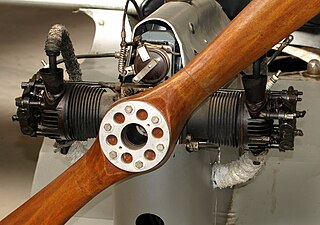
The ABC 8 hp is an 8 hp (6 kW) two-cylinder aero engine designed by the noted British engineer Granville Bradshaw for use in ultralight aircraft. The engine was derived from a specially tuned motorcycle unit and was built by ABC Motors, first running in 1923.

The Gloster Gannet was a single-seat single-engined light aircraft built by the Gloucestershire Aircraft Company Limited of Cheltenham, United Kingdom, to compete in the 1923 Lympne Trials. Engine development problems prevented it from taking part.
The Gnosspelius Gull was a 1920s British experimental ultra-light monoplane designed by Major O.T. Gnosspelius and built by Short Brothers at Rochester for the 1923 Lympne light aircraft trials.

The Vickers Vagabond was Vickers' entrant for the second Lympne light aircraft competition, held in 1924. It was a conventional small biplane, with a very unusual method of trimming. It was eliminated from the trials at an early stage and only one was built.

The Handley Page H.P.43 was a three-engined biplane bomber-transport built to an Air Ministry specification. It did not fly well and the biplane configuration was out-dated at completion; the only one constructed was later turned into a monoplane and led to the Handley Page H.P.54 Harrow.

The Handley Page Type E was a two-seat, single-engined monoplane intended as a demonstrator. Though only one was built, it flew successfully from 1912 to 1914, carrying several hundred passengers and flying several thousand miles.
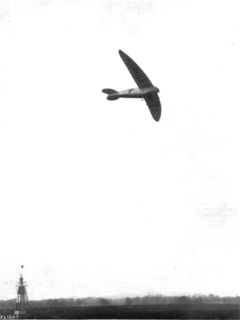
The Handley Page Type F was a two-seat, single-engined monoplane designed to compete for a War Office prize for a specified military machine in 1912. It crashed before the trials got under way and, although it flew well later, only one was built.
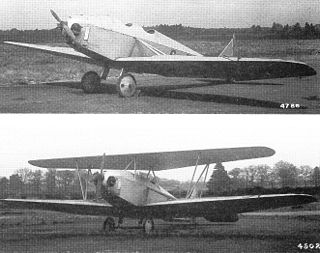
The Parnall Pixie was a low powered British single-seat monoplane light aircraft originally designed to compete in the Lympne, UK trials for motor-gliders in 1923, where it was flown successfully by Norman Macmillan. It had two sets of wings, one for cross-country flights and the other for speed; it later appeared as a biplane which could be converted into a monoplane.
The Beardmore Wee Bee was a single-engined monoplane built only once and specifically for the Lympne two-seat light aircraft trials held in the United Kingdom in 1924. This plane won the major prize.
The RAE Hurricane was a single-seat, single-engined light monoplane designed and built by the Aero Club of the Royal Aircraft Establishment for the 1923 Lympne Motor Glider Competition. It was underpowered with an unreliable engine. Re-engined, it flew in many races, with first place in the 1926 Grosvenor Challenge Cup its greatest success.
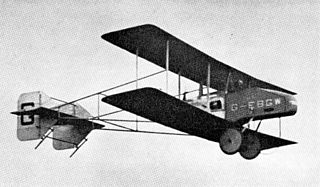
The RAE Zephyr was a single-seat, single-engined light pusher configuration biplane designed and built by the Aero Club of the Royal Aircraft Establishment (RAE) for the 1923 Lympne Motor Glider Competition. At a late stage the Aero Club chose to enter the more promising RAE Hurricane instead, using the Zephyr's engine, and the Zephyr itself was abandoned.

The Handasyde monoplane was a single-seat light aircraft built for the 1923 Lympne motor glider competition. It competed there but won no prizes.

The Farman Moustique is a family of French monoplanes built by the Société des Aéroplanes Henry et Maurice Farman at Billancourt.
The Pegna-Bonmartini Rondine, or Pegna Rondine, is a single-seat ultralight sport aeroplane designed by Giovanni Pegna and built by Piaggio in Italy during 1923.
The Gribovsky G-5 was a small, low powered Russian single seat sports aircraft from the late 1920s.
The Peyret Avionette was a low power, single seat French monoplane which won several first-place prizes at the Congrès Experimental contest of 1923.
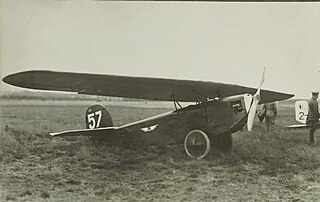
The Udet U 7 Kolibri (Hummingbird) was a single engine, single seat, parasol wing light aircraft, designed and built in Germany in the mid-1920s. Though they had some competition success and set an unofficial lightplane duration record, only two were produced.
The MIP Smyk, MIP from the initials of its Polish designers with Smyk meaning Brat or Kid, was an aerodynamically refined motor glider designed and built at Warsaw Technical University from 1935.
References
Notes
- 1 2 3 4 Barnes & James 1987 , pp. 239–44
- ↑ Barnes & James 1987 , pp. 599
- ↑ Flight 11 October 1923 p.626
- ↑ Flight 18 October 1923 p.640
- ↑ Lumsden, Alec (1994). British Piston Aero-engines and their Aircraft. Shrewsbury: Airlife. ISBN 1 85310294 6.
Bibliography
- Barnes, C.H.; James, D. N. (1987). Handley Page Aircraft since 1907. London: Putnam Publishing. ISBN 0-85177-803-8.CS1 maint: ref=harv (link)
- Lumsden, Alec (1994). British Piston Aero-engines and their Aircraft. Shrewsbury: Airlife. p. 51. ISBN 1 85310294 6.